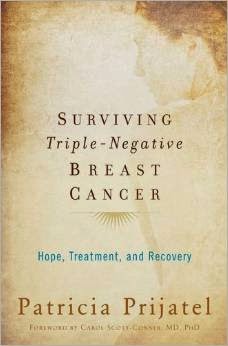This is what came to mind when I read Surviving Triple-Negative Breast Cancer: Hope, Treatment, and Recovery (Oxford University Press, 2014). The author, Patricia Prijatel, is a health journalist who, after being diagnosed with TNBC, a rare and aggressive form of breast cancer, undertook the same sort of research that my parents did years ago. Recognizing that many other patients could benefit from a concise book that guides the reader through the basics, she wrote Surviving TNBC.
In a warm tone, filled with empathy, Prijatel educates her readers on causes, treatments, risks, statistics, and other information while providing an extensive number of references for those who don’t mind delving further. You might ask why I think books like this needed. Sure, we have Wikipedia, but that doesn’t cover a whole lot. And it’s not like the average reader is going to want to go directly to the medical journals cited. Prijatel’s book does that for you. In other words, it has the potential to encourage those who never liked school to educate themselves about the disease.
Where I think the book’s chief disadvantage lies is the likelihood of it quickly becoming outdated, especially since TNBC is a “newer” disease about which more is constantly being discovered. It also is a bit technical at times, when I think an easy-read approach is warranted. In addition, I wish that it had a comprehensive bibliography at the end, rather than just the end notes after each chapter.
Is Surviving TNBC a tear jerker? Not really. While Prijatel does tell her personal story, she’s writing an informative book, not a biography. Readers looking for an emotional connection with another survivor might have to look elsewhere. Luckily though, Prijatel has a blog, Positives About Negative, that I suspect allows for more personal interaction. And from the looks of it she seems to be doing well, despite various setbacks – something in which her readers can most certainly take comfort.
Disclaimer: I received a uncorrected advance reading copy of this book through LibraryThing’s Early Reviewers program. I was not required to write a favorable review.




